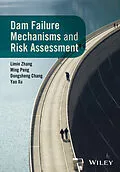Professor Limin Zhang, Hong Kong University of Science and Technology, China
Limin Zhang is currently Professor of Civil Engineering at the Department of Civil and Environmental Engineering, Hong Kong University of Science and Technology. His research areas include embankment dams and slopes, geotechnical risk assessment and foundation engineering.
Dr. Ming Peng, Hong Kong University of Science and Technology, China
Ming Peng is a Post-doctoral Research Associate at the Department of Civil and Environmental Engineering, Hong Kong University of Science and Technology. His research areas include risk analysis methodologies, flood vulnerability analysis and decision theory.
Dr. Dongsheng Chang, Hong Kong University of Science and Technology, China
Dongsheng Chang is a Post-doctoral Research Associate at the Department of Civil and Environmental Engineering, Hong Kong University of Science and Technology. Dr. Chang is an expert in internal erosion and overtopping erosion of dams. He invented a laboratory device to test the internal erodibility of soils under complex stress conditions.
Dr. Yao Xu, China Institute of Water Resources and Hydropower Research and Chinese National Committee on Large Dams, China
Yao Xu recently joined China Institute of Water Resources and Hydropower Research and Chinese National Committee on Large Dams after working as a Post-doctoral Research Associate at the Department of Civil and Environmental Engineering.
Zusammenfassung
This book integrates the physical processes of dam breaching and the mathematical aspects of risk assessment in a concise manner
• The first book that introduces the causes, processes and consequences of dam failures
• Integrates the physical processes of dam breaching and the mathematical aspects of risk assessment in a concise manner
• Emphasizes integrating theory and practice to better demonstrate the application of risk assessment and decision methodologies to real cases
• Intends to formulate dam-breaching emergency management steps in a scientific structure
Inhalt
Foreword by Kaare Høeg xiii
Foreword by Jinsheng Jia xiv
Preface xvi
Acknowledgements xviii
About the Authors xix
PART I DAM AND DIKE FAILURE DATABASES 1
1 Dams and Their Components 3
1.1 Classification of Dams 3
1.2 Constructed Embankment Dams 4
1.3 Landslide Dams 7
1.4 Concrete Gravity Dams 7
1.5 Concrete Arch Dams 8
1.6 Dikes 10
2 Statistical Analysis of Failures of Constructed Embankment Dams 11
2.1 Database of Failures of Constructed Embankment Dams 11
2.2 Failure Modes and Processes 11
2.2.1 Overtopping 16
2.2.2 Internal Erosion 17
2.3 Common Causes of Embankment Dam Failures 19
2.4 Failure of Different Types of Embankment Dams 21
2.4.1 Analysis of Homogeneous and Composite Earthfill Dams 23
2.4.2 Analysis of Earthfill Dams with Corewalls 23
3 Statistical Analysis of Failures of Landslide Dams 25
3.1 Database of Failures of Landslide Dams 25
3.1.1 Locations of Landslide Dams 25
3.1.2 Formation Times of Landslide Dams 26
3.1.3 Triggers of Landslide Dams 26
3.1.4 Types of Landslide 26
3.1.5 Dam Heights and Lake Volumes 32
3.2 Stability, Longevity, and Failure Modes of Landslide Dams 33
3.2.1 Stability of Landslide Dams 33
3.2.2 Longevity of Landslide Dams 35
3.2.3 Failure Modes 36
3.3 Mitigation Measures for Landslide Dams 37
3.3.1 Stages of Landslide Dam Risk Mitigation 38
3.3.2 Engineering Mitigation Measures for Landslide Dams 39
3.3.3 Engineering Measures for the Landslide Dams Induced by the Wenchuan Earthquake 41
3.3.4 Mitigation Measures for the Tangjiashan Landslide Dam 51
4 Statistical Analysis of Failures of Concrete Dams 53
4.1 Database of Failures of Concrete Dams 53
4.2 Failure Modes and Processes 53
4.3 Common Causes of Concrete Dam Failures 55
5 Statistical Analysis of Failures of Dikes 57
5.1 Introduction 57
5.2 Database of Dike Breaching Cases 57
5.3 Evaluation of Dike Failure Mechanisms 59
5.3.1 Most Relevant Failure Mechanisms 59
5.3.2 Statistics of Observed Failure Mechanisms 62
PART II DAM FAILURE MECHANISMS AND BREACHING PROCESS MODELING 67
6 Internal Erosion in Dams and Their Foundations 69
6.1 Concepts of Internal Erosion 69
6.2 Mechanisms of Initiation of Internal Erosion 72
6.2.1 Concentrated Leak Erosion 72
6.2.2 Backward Erosion 73
6.2.3 Contact Erosion 73
6.2.4 Suffusion 74
6.3 Initiation of Concentrated Leak Erosion Through Cracks 74
6.3.1 Causes of Concentrated Leak 75
6.3.2 Need for Studying Soil Erodibility for Concentrated Leak Erosion 80
6.3.3 Laboratory Tests on Concentrated Leak Erosion 81
6.3.4 Factors Affecting Concentrated Leak Erosion 83
6.3.5 Soil Dispersivity 84
6.4 Initiation of Backward Erosion 87
6.4.1 Susceptibility of a Dam or Dike to Backward Erosion 87
6.4.2 Methods for Assessing Backward Erosion 89
6.4.3 Formation of a Pipe due to Backward Erosion 92
6.5 Initiation of Contact Erosion 93
6.5.1 Fundamental Aspects of Contact Erosion Process 94
6.5.2 Laboratory Investigation on Contact Erosion 96
6.5.3 Threshold of Contact Erosion 100
6.6 Initiation of Suffusion 102
6.6.1 Control Parameters for Likelihood of Suffusion 102
6.6.2 Laboratory Testing of Suffusion 103
6.6.3 Geometrical Criteria for Internal Stability of Soils 108
6.6.4 Critical Hydraulic Gradients for Suffusion 115
6.7 Filter Criteria 120
6.7.1 Functions of Filter 120
6.7.2 Filter Criteria 121
6.8 Continuation of Internal Erosion 124
6.9 Progression of Internal ...
